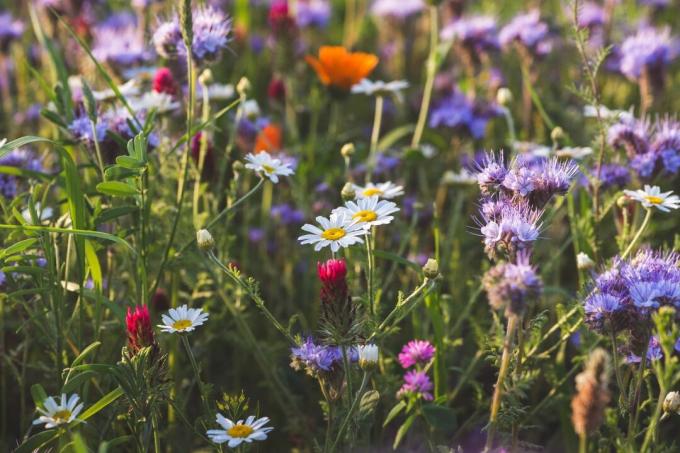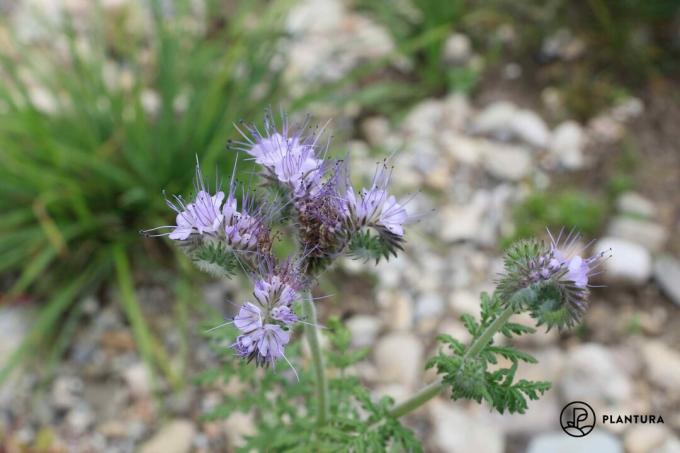The phacelia (also called tufted beauty, phacelia or bee friend) not only inspires bees in the garden with its flowers. We reveal what you should consider when sowing, planting and caring for the Phacelia.

The phacelia can be found in autumn on harvested fields as green manure and in many flowering mixtures for the home garden or balcony box. In this article you will find out what makes the phacelia so attractive for people and nature.
contents
- Phacelia: flowering time, origin and characteristics of the bee friend
- Phacelia varieties
-
Sow Phacelia
- The right location for the Phacelia
- How to properly plant phacelia seeds
- Caring for beautiful tufts: our tips for phacelia
- Is the phacelia poisonous?
- Use of Phacelia as green manure
Phacelia: flowering time, origin and characteristics of the bee friend
Phacelia is a genus of borage family native to America (Boraginaceae), to which also the Adderhead (Echium vulgare), the
Comfrey (Symphytum officinale) and the forget Me Not (Myosotis sp.) count. To the genus Phacelia include around 150 different species that grow as annuals, biennials or perennials. With us, however, one only uses and knows the annual, non-hardy tansy-leaved Tussock (Phacelia tanacetifolia). Its leaves are doubly pinnate and their shape is reminiscent of the foliage of tansy (Tanacetum vulgare). It reaches heights of growth of up to 120 centimeters and forms long inflorescences that unfurl outwards and blossom from the middle to the top. The individual flowers are fivefold, the petals white, violet or blue in colour. The stamens and stigmas protrude conspicuously from the flower. The tansy phacelia flowers from June to October, depending on the sowing date, and offers eager pollinators large quantities of very sugary nectar. This property also makes it a particularly popular beekeeping plant.Phacelia varieties
- Phacelia tanacetifolia 'Angelia' has a strikingly beautiful, light blue flower. The variety is undemanding and drought tolerant. It quickly forms a lot of biomass and is therefore well suited as a green manure plant.
- Phacelia tanacetifolia 'Stala' bears light purple to white petals with darker stamens. It is an annual and well suited for freezing winter greening.
- Phacelia campanularia 'Blue Bonnet' shines in royal blue and shows great accents with its large, white stamens. It reaches heights of about 25 cm and flowers 8-10 weeks after sowing.
- Phacelia grandiflora 'Summertime Blues' delights us with a mix of royal blue petals, white calyx and stamens. The annual variety grows to a height of 40 to 60 cm.

Sow Phacelia
The ones used in our latitudes Phacelia-Species and varieties are annual and are propagated by sowing. You can find everything you need to know about growing the beautiful tufts in your own garden here.
The right location for the Phacelia
The phacelia is generally quite undemanding and drought tolerant. It loves deep, humus-rich soil with good drainage, but will grow in almost any soil that is not waterlogged.
How to properly plant phacelia seeds
The small, brown and conspicuously ribbed seeds are sown directly into the ground between April and September. The sowing depth is 1 to 2 cm. A row spacing of about 15 cm gives the phacelia room to spread its leaves. Larger areas can be spread, easily worked in and rolled on. During the short germination period of about 10 days, the soil should always be kept moist.

Caring for beautiful tufts: our tips for phacelia
Depending on the variety, the first flowers appear after only 5 to 8 weeks. Until then, at least in extremely dry periods, it should be watered a little. Otherwise, the phacelia does not require any care. For propagation, you can let some inflorescences mature and harvest the seeds. They should be dried indoors. The seeds are viable for about 4 to 5 years.
Is the phacelia poisonous?
The tuft is not poisonous, but all phacelia contain skin-irritating substances that can trigger an allergic reaction. You should therefore wear gloves whenever you handle the bee friend. The phacelia is also harmless for animals, it is considered a harmless forage plant.

Use of Phacelia as green manure
The tansy phacelia does not need any fertilizer during its short vegetation period, it roots down to a depth of 60 cm and uses the available nutrients. Many plants do not even reach such depths, but the phacelia brings the minerals up, first uses them in their biomass and later serves as green manure. If cultivation takes place in spring, the tufts are mulched after flowering and before the seeds ripen and worked into the soil. If sown in late summer or autumn, the phacelia can be left until the first frost in October or November. It freezes reliably and remains as a nutrient store until spring. Now it is incorporated and as soon as it gets warmer, the hungry soil organisms begin to decompose.
The phacelia is a favorite of various species of bees, as it is one of the few nutritious flowering plants in summer and offers both nectar and pollen. The plant is therefore not only valued by beekeepers and popularly referred to as a "bee friend".
Is there also a spot in your garden or on the balcony for a species-rich flowering meadow? We give tips on choosing and Planting a bee pasture.

